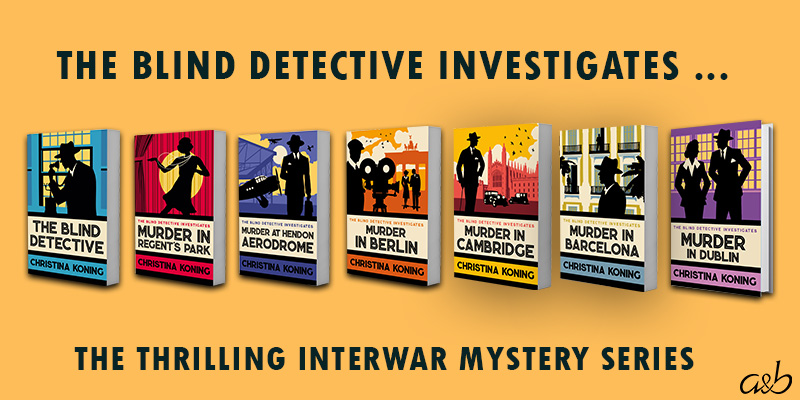Writing the ‘Blind Detective’ series – A guest blog post from Christina Koning
Our Author of the Month for October is Christina Koning, author of the Blind Detective series. This month, we publish two more books in the ongoing interwar series – Murder in Cambridge and Murder in Barcelona. In this blog post, Christina reflects upon writing the series.

When, in 2014, I started writing the first book in what is now the Blind Detective series, I had no idea that it would turn into a murder mystery – let alone a series. I’d simply decided to write a novel based around the life of my maternal grandfather, a veteran of the First World War, as a way of marking the centenary of the war’s outbreak. It was only as I got deeper into the story, whose central character, Frederick Rowlands (like my grandfather, a blinded war survivor), works as a switchboard operator for a firm of City solicitors, that I recognised its potential as a whodunnit – and my hero’s role as a (somewhat reluctant) detective.
From that moment on, the mingling of historical research with the tight plotting necessary to keep the action moving along, has continued to engage me. My earlier literary novels had a variety of historical settings, from the eighteenth century to the 1970s, and so writing historical crime fiction seemed like a natural progression. The Blind Detective novels are set at two-year intervals, beginning in 1927, and cover the interwar years and the beginning of the Second World War (I have reached 1943 at the time of writing).The locations vary – from London in the late twenties, to Berlin in the early thirties, Barcelona during the Civil War, and Dublin on the eve of the Second World War.
Throughout, events taking place on the world stage are mirrored by those in which my detective finds himself caught up. Thus, while the first book, The Blind Detective, dealt with the aftermath of the Great War, the second, Murder in Regent’s Park, ends just before the Wall Street Crash of 1929. The worldwide financial crisis this precipitated forms the background to Murder at Hendon Aerodrome, the third novel in the series, which is set in 1931 – although the book’s main focus, as the title suggests, is the flying craze of the early 1930s. With Murder in Berlin, set in that city in 1933, as Hitler comes to power, the personal and the political become even more intertwined, as Rowlands goes to Berlin to track down a missing child and is caught up in the tumultuous events of the times.
Running parallel to the historical events described in the Blind Detective books, are those concerning Rowlands’s family and friends. Other crime writers – Ian Rankin, in his ‘Rebus’ books, for example, or Henning Mankell in his ‘Wallender’ series – have focused on their protagonist’s (often dysfunctional) private life, with recurring characters appearing in successive stories. In my own series, Rowlands’s wife, Edith, and their three daughters, as well as a number of other important characters, appear at different stages in their lives, each playing a part in the action, to varying degrees. This was both a way both of indicating the passage of time, but also of showing how individual lives are part of history. In the book I’m currently writing, Rowlands’s middle daughter, Anne – whom we first meet as a five year-old – is now twenty-one, and serving with the WAAFs at a wartime airbase.
Even though researching the social and political background is enthralling, I try to keep in mind that these are principally detective stories, focusing on murder and other nefarious crimes. Again, the historical background isn’t just set-dressing, but has a bearing on the plot – with, for instance, the prevailing violence of Nazi-era Berlin echoed in the murderous events Rowlands finds himself investigating in that story. Similarly, Murder in Barcelona links two seemingly unconnected plot strands – the murder of an actress, during a film shoot in Cornwall, and the turbulent events of civil war-torn Barcelona – revealing themes of betrayal common to both. Murder in Dublin, set in neutral Ireland as war breaks out in Europe, sets a tale of internecine warfare within an aristocratic family against the wider conflict. Even when the story focuses on events nearer to home, as in Murder in Cambridge, in which Rowlands become involved in the suspicious death of a female student at a Cambridge college, it becomes clear that the mystery must be seen in a wider context –with, in this instance, the struggle for women’s education very much to the fore.
Writing the Blind Detective series has given me a wonderful opportunity to explore this particular period of the past, and to consider themes such as the rise of fascism in Europe, women’s rights, and the way that individual lives are affected by war, while constructing what I hope are intriguing mysteries. That the events which took place around a century ago still resonate throughout the present day makes them, to my mind, entirely relevant. And – serious themes aside – it has given me the chance to immerse myself in the glamour and elegance of the 1930s, as well as the more austere, but no less fascinating, wartime years. If nothing else, the books pay homage to that Golden Age of crime writing which exactly corresponds to the period in which my books are set, and without which they would never have been written.
To learn more about the Blind Detective series, click here.
To learn more about Christina Koning, click here.


